Bird visitors at my window
Over recent days we have had both hot weather and lovely weather. This is normal for mid-summer days here in South Australia. For any new readers, I live about 80km or an hour’s drive south-east of Adelaide. Summer temperatures are usually in the high 20s or low 30s (30C is equal to 86F). During our worst summer days, temperatures can soar as high as 45C (113F), but thankfully such days only occur a few times every year.
Over recent weeks, many days have been in the mid-20s, which is very pleasant. On such days I love to open the large window next to my writing desk and let the fresh air into my office. If there is a breeze as well, that is an added bonus. One of the side benefits of this arrangement is the easy access to the bird life in our garden. I don’t even have to get up out of my chair to watch the birds. They come to me.
One one occasion, a friendly Australian Magpie (see photo above) sat on the rail of the pergola on this side of the house. He was in full view from where I sat. He suddenly stopped his carolling – our magpies are wonderful songsters – realised I was there and leant forward to get a better view of me. When I chatted with him, thanking him for the visit and the song, he answered me. How lovely.
On several occasions over the last week, one or two Peaceful Doves have alighted in the branches of a nearby tree, coo-ing persistently for about ten or fifteen minutes before moving on elsewhere in our garden. Their soft calls are very peaceful, so they are aptly named.
Only yesterday I had to stop what I was writing and look out to the garden bed next to my office window. A small family of White-browed Babblers were playing around in the bushes there, scolding each other as they scurried here and there. They were joined in this game by several New Holland Honeyeaters, their screeches usually a warning sign that a hawk or eagle is about. I think they were just having fun with the babblers. Even a couple of House Sparrows joined in the fun.
One species we don’t always have around is the Rainbow Bee-eaters, a delightfully named bird with their many-coloured plumage and their liking for catching and eating bees and other flying insects. I smile when I see one sitting in a nearby tree, banging a bee against the branch to dispatch the sting of the bee before swallowing it whole. Yesterday two or three could be heard out of my window while I worked, and later I saw two gliding overhead. Delightful birds, and we miss them when they fly north for the winter.
For many years we never had wrens resident in our garden. They were only occasional visitors from up the hill. Then five years ago on our return from an overseas trip, we were greeted by two Superb Fairy-wrens, one of two local species. They have been a resident breeding species in our garden ever since, producing several broods over those five years. They are so secretive about their nests that I have yet to find one. They have plenty of good bushes around to build their nests. From time to time they will also come by my office, their twittering, tinkling calls easy on the ears as they hop along near my office window, jumping up occasionally to snatch a fly or mosquito silly enough to hang around too long.
I don’t need to have the window open to hear our resident Mallee Ringneck parrots screeching outside as they fly from tree to tree, or over the house, or just sitting in a nearby tree wagging their tails joyfully. This tail wagging is probably a mating display. They have raised several broods successfully in recent years, their nest hollow being only 30 metres from my window.
What birds do you have in your garden?
Please tell me in the comments.
Good birding,
Trevor
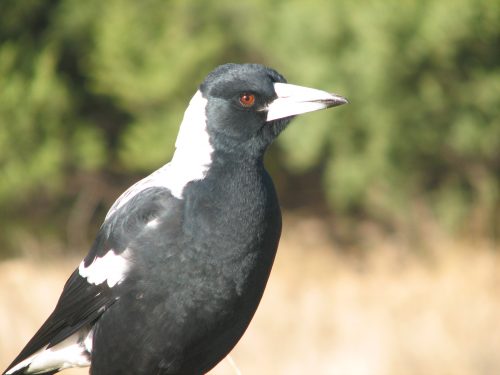
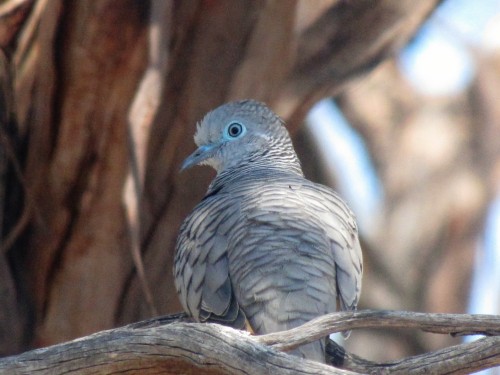
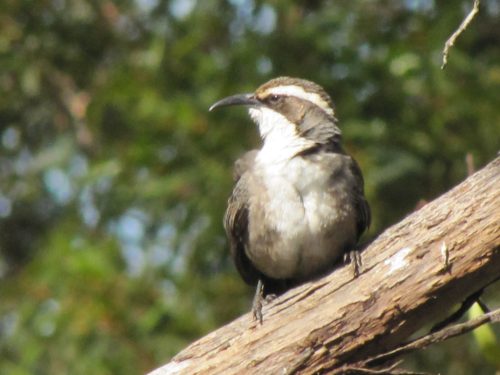
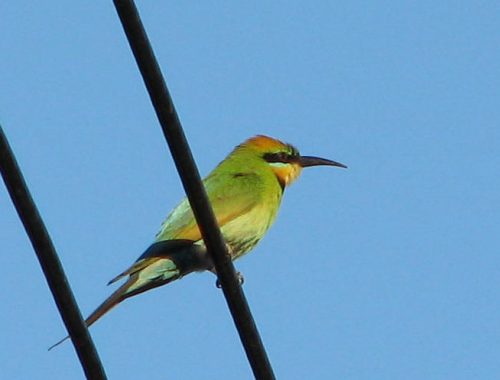
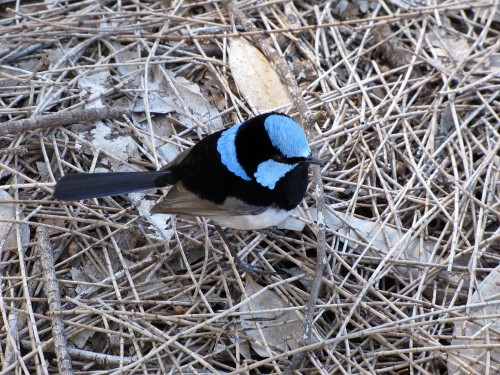
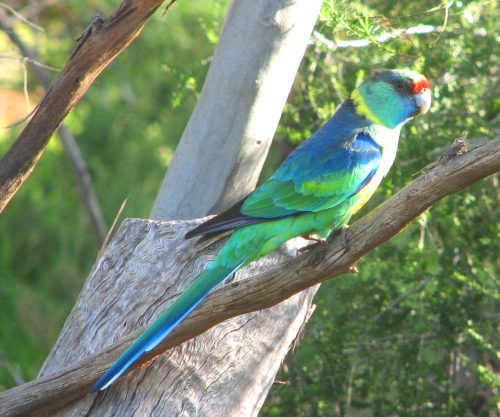
Not so balmy in Western Sydney. We have had nothing under 26C for 36 days. There were 10 consecutive days over 30C, including sets of 2 days over 40C. We had, in January, 6 days over 40C. The other day it was 45C in our backyard. A lorikeet fell out of a tree in front of me. It staggered under a barrow and sat for a while. Then it fluttered into our dwarf lillpilly tree, which is dense and shady. When I checked an hour later it was gone.
The worry is that in such a condition it will end up in the claws of a cat. Our new climate is bad news for more than just humans.
Hi Ken,
I am pleased that we decided not to visit our son and hs family during January. I was chatting with my 8yo grandson recently (he rings nearly every week) and he told me that it had been very hot during the school holidays. They live in Artarmon. I just couldn’t stand that kind of heat plus Sydney’s humidity. we’ve had a few humid days here in SA, but they are so rare that we really struggle to cope.I like our nice clear non-humid heat.
Trevor, you seem to think SA is going to miss out on these changes. But they are coming for all of us. This summer in NSW is not normal. In fact we have just set records for heat that has never been recorded in Australia, and that in February. We had 47 degrees in our area. It was 48.5 on our front veranda under the steel bullnose roof. For a day or two NSW was the hottest area on the entire planet. Yay for us!
I know of one rabbit and one guinea pig that died. The owners thought that just giving them a bit or extra water would help, and that they would just go into their little box for shelter. Inside those boxes it was hot enough to kill them from heat exhaustion. We are going to have to learn how to live with these new conditions.
Walking around the suburb gave us clues as to what to avoid and what to foster. Under any trees in a park it was cool. Walking past masonry walls you could feel the heat radiating against your skin. And that was in the days after the temperature dropped. It will be interesting to see if we get any sort of winter this year.
We live in Queensland in the South Burnett. I homeschool my boys and they love birds! We have King Parrots, Grey-Crowned Babblers, Apostlebirds, Bar-shouldered Doves, Crested Pigeons, Magpie Larks, Grey Shrike Thrushes, Pheasant Coucals, Pied Butcher birds, Magpies, Willy-Wag Tails, Rainbow Lorikeets, Pale Headed Rosellas, Fig birds, Australian Wood ducks, sometimes a grey Heron, sometimes Black cockatoos, Sulpher-crested cockatoo, Roseate cockatoos aka galahs, Yellow Thornbills, Fairy Wrens, Noisy Friarbirds, Bluefaced Honeyeaters, Kookaburras, Sacred Kingfishers, White-Winged Chough and Scrub Turkeys. There might be 1 or 2 I’ve left out but I think that’s about all we’ve observed so far. We’ve only lived here for about 5 months. There was one blue coloured bird that may have been a Dollar bird but we only saw its back and for a few seconds only so can’t be sure. Love your blog too Trevor, such great info and great to see your obvious passion for our feathered friends
Hi Stephanie,
Thanks for stopping by and leaving your comments. I am very jealous of you and the birds you see on a regular basis. Some of those are species I have not seen in the wild. I am planning a caravanning trip up to Queensland at some stage, but no dates yet.
Thank you too for your kind comments about my blog site. I love sharing photos and stories about the birds I see.
Thought I’d add that we also have Whipbirds and double bar finches there are a few birds we haven’t been able to identify, I think a species of honeyeater and another species with a speckled chest. Theres also a species we hear but never see, it makes a little beep noise every few seconds, its quite loud and seems to come from the gumtree behind our house.
Hi again Stephanie,
The bird making the “beep” noise is possibly one of the Pardalote species, probably a Striated Pardalote (or Spotted). They are tiny and feed on insects in the canopy of trees. Sometimes very hard to see.